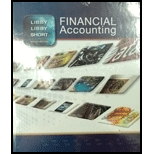
1.
Find the number of shares authorized, shares issued, and shares outstanding of Corporation N as of December 31, 2014.
1.
Explanation of Solution
Shares:
The common stock is divided into smaller units of equal value called as Shares and issued to the public, to raise funds.
- The shares authorized by the Corporation N are 200,000 shares.
- The number shares issued by the Corporation N is 125,000 shares.
- The number of shares that stands outstanding in the Corporation N is 122,000 shares.
Working Notes:
Calculate the number of shares issued.
Calculate the number of shares outstanding.
2.
Find the balance in the capital in excess of par account.
2.
Explanation of Solution
Additional paid-in capital: The excess amount raised from the stock issuance above the par value represents additional paid-in capital. This is otherwise known as capital in excess of par account.
Calculate the capital in excess of par account.
Therefore, the amount of capital in excess of par is $875,000.
3.
Identify the amount of earnings per share.
3.
Explanation of Solution
Earnings per share:
Earnings per share represent the amount of income earned per share of outstanding common stock in a period. This ratio is used for analyzing the profitability of company’s stockholders.
The following formula can be used to calculate earnings per share:
Calculate the amount of earnings per share.
Therefore, the earnings per share are $1.97.
4.
Identify the amount of dividend paid per share.
4.
Explanation of Solution
Cash dividend: The amount of cash provided by a corporation out of its distributable profits to its shareholders as a return for the amount invested by them is referred as cash dividends.
Calculate the amount of dividend paid per share.
Therefore, the amount of dividend paid per share is $1.01.
5.
Identify the balance sheet section in which
5.
Explanation of Solution
Treasury Stock: It refers to the shares that are reacquired by the corporation that are already issued to the stockholders, but reacquisition does not signify retirement.
The treasury stock should be reported in the
Reported amount of treasury stock is $60,000.
Working Note:
6.
Identify the par value per share and outstanding number of shares after the 100% stock split.
6.
Explanation of Solution
Par value: It refers to the value of a stock that is stated by the corporation’s charter. It is also known as face value of a stock.
Stock Splits: It is a method of increasing the total number of outstanding shares thereby, reducing the market price of each share, however, keeping the corporation’s total market value constant.
Outstanding stock: It refers to the number of shares that are held by the existing stockholders of the company.
Determine the par value per share after the 2-for-1 stock split (100% stock split).
After the 2-for-1 stock split, the par value per share of Corporation N will be $5.
Determine the outstanding number of shares after stock split.
After the 2-for-1 stock split, the outstanding number of shares after stock split of Corporation N will be 244,000 shares.
7.
Provide the
7.
Explanation of Solution
Stock Splits: It is a method of increasing the total number of outstanding shares thereby, reducing the market price of each share, however, keeping the corporation’s total market value constant.
2-for1 stock split increases increase the number of shares by double and decrease the stock price per share by half.
Stock split does not affect total assets, total liabilities, or total stockholders’ equity. Hence, no journal entry is required to be passed.
8.
Provide the journal entry to record the stock dividend.
8.
Explanation of Solution
Stock Dividends: It refers to the payment of dividends by a company to its existing shareholders, in the form of additional shares rather than cash. Stock dividends are paid, when there is inadequate cash available in the company.
Corporation N has declared 10% stock dividend, hence this is a small stock dividend.
Prepare journal entry to record the small 10% stock dividend.
| Date | Account Titles and Explanation |
Debit (Amount in $) |
Credit (Amount in $) |
| 256,200 | |||
| Common Stock (+SE) (2) | 122,000 | ||
| Additional Paid –in Capital (+SE) (balancing figure) | 134,200 | ||
| (To record the declaration of small stock dividend) |
(Table 1)
- Retained earnings are a component of stockholder’s equity and there is a decrease in the value of equity. Hence, it is debited.
- Common stock is a component of stockholder’s equity and there is an increase in the value of equity. Hence, it is credited.
- Additional paid-in capital is a component of stockholder’s equity and there is an increase in the value of equity. Hence, it is credited.
Working Notes:
Calculate the amount of decrease in retained earnings.
Calculate the amount of increase in the value of common stock.
Note: SE in journal entry represents Stockholders’ equity.
Want to see more full solutions like this?
Chapter 11 Solutions
Financial Accounting - With Access

 AccountingAccountingISBN:9781337272094Author:WARREN, Carl S., Reeve, James M., Duchac, Jonathan E.Publisher:Cengage Learning,
AccountingAccountingISBN:9781337272094Author:WARREN, Carl S., Reeve, James M., Duchac, Jonathan E.Publisher:Cengage Learning, Accounting Information SystemsAccountingISBN:9781337619202Author:Hall, James A.Publisher:Cengage Learning,
Accounting Information SystemsAccountingISBN:9781337619202Author:Hall, James A.Publisher:Cengage Learning, Horngren's Cost Accounting: A Managerial Emphasis...AccountingISBN:9780134475585Author:Srikant M. Datar, Madhav V. RajanPublisher:PEARSON
Horngren's Cost Accounting: A Managerial Emphasis...AccountingISBN:9780134475585Author:Srikant M. Datar, Madhav V. RajanPublisher:PEARSON Intermediate AccountingAccountingISBN:9781259722660Author:J. David Spiceland, Mark W. Nelson, Wayne M ThomasPublisher:McGraw-Hill Education
Intermediate AccountingAccountingISBN:9781259722660Author:J. David Spiceland, Mark W. Nelson, Wayne M ThomasPublisher:McGraw-Hill Education Financial and Managerial AccountingAccountingISBN:9781259726705Author:John J Wild, Ken W. Shaw, Barbara Chiappetta Fundamental Accounting PrinciplesPublisher:McGraw-Hill Education
Financial and Managerial AccountingAccountingISBN:9781259726705Author:John J Wild, Ken W. Shaw, Barbara Chiappetta Fundamental Accounting PrinciplesPublisher:McGraw-Hill Education





